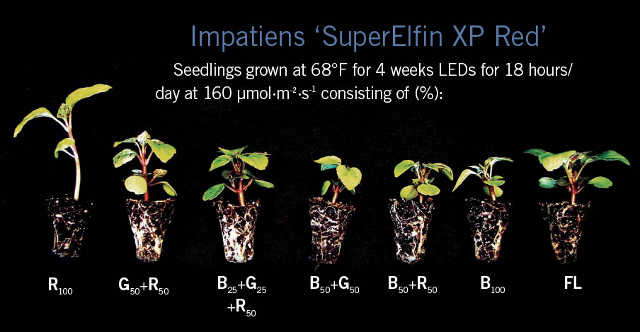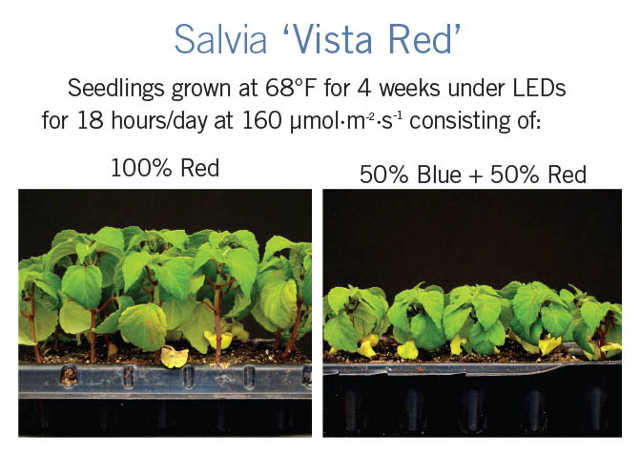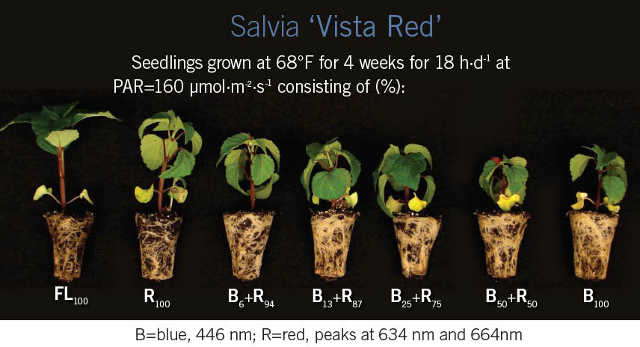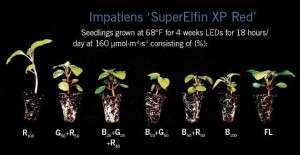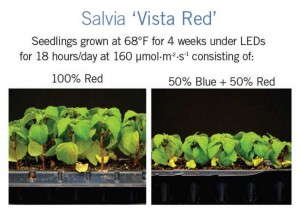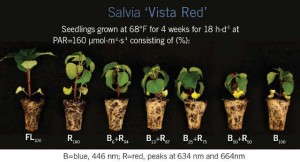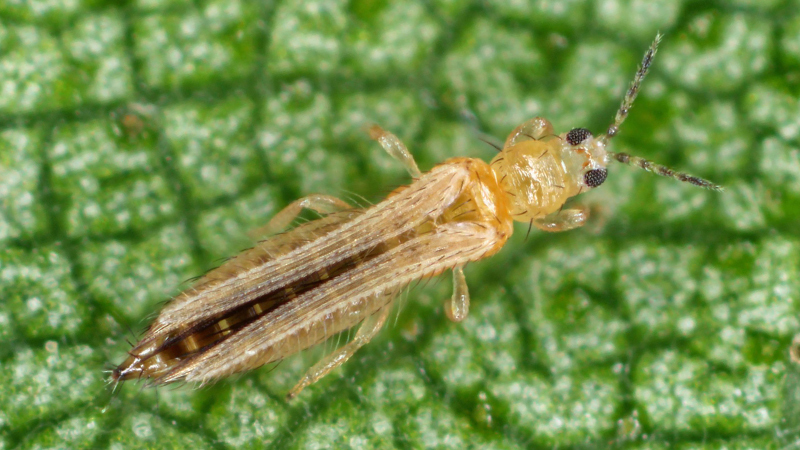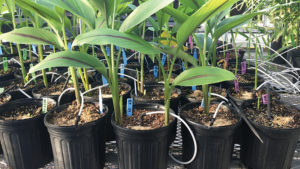Growing Seedlings Under LEDs: Part Two
Light-emitting diodes (LEDs) present opportunities for horticultural lighting because of their high electrical efficiencies and tunable light spectrums. Today, LED arrays are similarly or more efficient than conventional lamps such as high-pressure sodium (HPS) or fluorescent, and their efficiencies continue to increase. The wavelengths, or colors, of commercially available LEDs vary widely, which allows unique mixtures of colors to be developed that can result in desirable growth responses. For example, manipulating light quality to produce short, well-branched plants could reduce the need for plant growth retardants or other height-suppressing strategies.
In Part I of this article (January GG), we presented results from our indoor LED lighting experiment with orange, red and hyper red light. We concluded that because plants grew similarly under different colors of red light, red LEDs for horticultural applications could be chosen based on their longevity, efficiency and cost, without affecting plant quality.
In our second experiment, tomato ‘Early Girl,’ salvia ‘Vista Red,’ petunia ‘Wave Pink’ and impatiens ‘SuperElfin XP Red’ were grown in growth chambers, beginning after germination, for four weeks at 68°F. The photosynthetic light intensity was fixed at 160 µmol∙m-2∙s-1 and was delivered for 18 hours each day. Light was delivered using different percentages of blue (B; peak of 446 nm), green (G; peak of 516 nm) and red (R) light. The red light was delivered by equal intensities of two different LEDs with peak wavelengths of 634 or 664 nm. The LED treatment percentages were: B25+G25+R50 (25 percent of light from blue and green LEDs and 50 percent from red LEDs), B50+G50, B50+R50, G50+R50, R100 and B100. Plants were also grown under cool-white fluorescent lamps to serve as a control treatment. A variety of data were collected, including the fresh weight of the shoots, seedling height and total leaf area.
[blackoutgallery id=”55866″]Plants Grown Under Different Color Light Finished At Various Heights
Plants were 40 to 60 percent shorter when grown under at least 25 percent blue light as compared to plants grown under only red light (Figures 1 and 2). Plants grown under 50 percent green light were shorter than those under all red, but taller than those grown with some blue light. The leaf area of plants grown under only red light was 50 to 130 percent greater than with 25 percent or more blue light. Similarly, plants had 50 to 110 percent greater shoot fresh weight under only red light than plants under 25 percent or more blue light (Figure 3). Plants grown under fluorescent lamps often had fresh weight and leaf area similar to that of the plants grown under only red light, while their height was similar to plants under the G50+R50 treatment. Impatiens was the only species to produce flower buds during the experiment, but only under at least 25 percent blue light. The number of leaflets of tomato that developed edema was greatest under only red light, and edema decreased as the percentage of blue light increased.
In a third experiment, the same species of bedding plants were grown for four weeks, also at 160 µmol∙m-2∙s-1, under different percentages of blue and red light. The LED treatments were all red (R100), all blue (B100) or the following percentages: B6+R94, B13+R87, B25+R75 and B50+R50. The red light was delivered by two different red LEDs as in the previous experiment. Plants grown under at least 6 percent blue light were 25 to 50 percent shorter than plants without any blue light (Figure 4). Leaves of impatiens, salvia and petunia were approximately twice as large when grown under only red light compared to leaves on plants under at least 50 percent blue light. Similar to the second experiment, providing an increasing percentage of blue light resulted in more flower buds on impatiens and less edema on tomato.
LEDs Can Help Growers Produce Young Plants With Desired Growth Attributes
We can conclude that adding blue light to the spectrum inhibits stem elongation and leaf expansion, while growing plants under only red light can increase stem length and leaf size. Twenty-five percent green light can substitute for 25 percent blue light without affecting fresh weight, but plants will be taller. However, the electrical efficiency of green LEDs on the market today is much lower than that for blue LEDs, so the economics of using green LEDs in young plant production are probably unfavorable. Adding blue light to a red-dominant environment stimulated flowering in impatiens and decreased the incidence of edema in tomato.
The ratio of blue and red light can be adjusted to produce seedlings with desired leaf sizes and stem lengths. Red light increased leaf size and stem length, which resulted in plants that had the greatest biomass. Plants under at least some blue light were more compact and generally were of greater horticultural quality, but leaf size was also reduced, which subsequently suppressed shoot growth.
This information can be used to help growers produce young plants with desired growth attributes, which can’t easily be done with conventional lighting technologies Light spectra could even be fine-tuned during crop production; for example, the proportion of blue light could be increased if seedlings are getting too tall.
Editor’s Note: The authors thank Mike Olrich for his technical assistance, funding from Osram Opto Semiconductors, the USDA Floriculture and Research Initiative and private companies that support MSU Floriculture.





